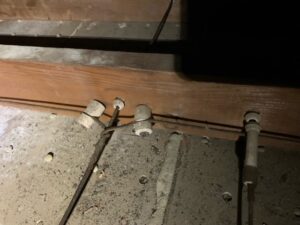Do things seem out of place with your electrical system? Are lights flickering, breakers tripping, strange smells and sound creating a nuisance in your home?
Then you might need to rewire your house.
In this series, we will take you through the process of complete home rewiring.
The Homeowner’s Guide to Rewiring a House
Before You Rewire

First steps to take include knowing your needs. Apart from changing the actual wires in your home, rewiring can also include upgrading your electrical panel, adding new connections for future use, and changing unsafe installations.
Electrical panels are often upgraded from 60 amps to 100 amps or 200 amps in modern homes. This gives your service panel a greater capacity to serve your electrical needs. You get to add appliances without fear or worry.
New connections that can be used for future installations are often included in a home rewire. This makes it easy and cheaper to use the new installations when the time comes.
Electrical connections like outlets, switches, USB ports, and others can also be replaced with safer versions. For example, if the outlets lack GFCI or are loose and faulty, they have to be changed.
Choose Rewire Route
There are two ways you can rewire your home. One is to Do it yourself as a DIY project or hire an electrical technician to do it for you. The DIY approaches to a home rewire is not advisable because of how dangerous it can get. You will be dealing with a lot of electrical components and without proper knowledge and experience, you can hurt yourself. There is also the issue of not knowing recent codes for house wiring. This would make your home non-compliant and become a problem once anything goes wrong.
DIY would take more time, be extremely stressful, and might undergo repeated inspections before you get it right.
If you succeed in rewiring your home, you are obligated to stay in it and not rent or sell the property for a stipulated time.
Hiring an electrician on the other hand makes things much easier. All you have to do is make a plan with the technician, approve the work contract, and pay to have the work done. The electrician brings the necessary tools, experience, knowledge, and personnel to complete the project.
When you have completed your rewire with either process, you will need to test everything thoroughly to be sure they work. Test before concluding the contract with an electrician and before the inspection is due.
A rewire is important to add value to your home and keep you safe, so make sure it’s properly completed.
Knowing When To Rewire
The decision to rewire your house might have been born out of several reasons like replacing faulty electrical installations, upgrading your home’s electric circuit system, or converting the basement to a state-of-the-art mini home theater. To ensure that it is properly done, there are a few guidelines outlined below to consider before donning your hand gloves and safety boots.
- Make A Rewiring Plan
As obvious as this sounds, its importance is commonly under-emphasized. If you’re rewiring your house yourself, you’d need to both consider what you want and how you want to install it and plan accordingly. If you’re hiring an electrician to do the work, all you’d need to do is decide what you want and let the electrician worry about how it’s going to fit into your house’s circuit system.Make a list of all electronic gadgets and appliances currently in the house, including those you intend to upgrade or buy in the near future.
You need to take into consideration home features like:
- Lighting fixtures, ceiling fans, HVAC (heating, ventilation, and air conditioning) systems;
- Kitchen fittings and appliances such as deep freezers, food processors, microwaves, ovens, dishwashers;
- Home office electronics such as PCs, fax machines, charging ports;
- Home entertainment systems such as TVs, sound systems, video game consoles;
- Leisure or hobby-related fixings such as hot tubs, swimming pools, tool sheds; treadmills, just to mention a few.
As soon as you’ve decided what you want included, create a simple drawing of your home showing as many of your electronics, appliances, lights, sockets, and switches, and any other important fitting as possible to help your electrician plan and design your home’s electrical circuits.
Ensure you review the plan with your electrician who is in the best position to provide practical, cost-effective feedback on how best to achieve your rewiring goals without risking your family’s safety.
- Create a Budget
After drafting a suitable plan, the next stage is making a budget for your home rewiring project. The most important factor to consider when creating a budget is arguably the size of your house, and how much of it you want to rewire.
If you’re working with a lean budget, you can divide the rewiring project into sections and rewire each section as your budget allows.
You can also reduce costs by doing some of the groundwork– moving furniture, cleaning the basement – you otherwise would have been charged for before work begins.It is advisable not to sacrifice quality in the name of cutting costs. This is especially important when it comes to the type of materials used for your rewiring work as the goal is to have satisfactory and long-lasting wiring installed. Carry out thorough research on the type of materials your electrician uses and ensure it meets acceptable industry quality standards.
Home rewiring is necessary to protect your electrical appliances from damages so that they can last longer. It also protects you from accidents that could happen because of outdated wiring.
You might not feel motivated to rewire your house because of how costly and demanding the rewiring process can be. But, it’s important to look at the bigger picture by considering all the risks that would be avoided after rewiring. We are continuing with our guide to help you rewire your house.
Invest In a Qualified Electrician

You can also do your research online and locate electrical professionals close to you. Discuss with the electricians recommended, be sure of their licensing, and make sure to settle on costs and fees before making your final choice. After this, you can start the rewiring process.
When checking if the electricians recommended are qualified, look for a company that possesses a license for a master electrician. This is a professional license while the license of an electrical contractor is only a license for the business. You have to be a master electrician to possess the license of an electrical contractor.
Another thing to look out for is that the electrician is insured and possesses general liability insurance.
Expect a Disruption in Electricity
Improvement projects disrupt the normal flow of activities in a home, electrical rewiring is no exception. If you’re wondering how long the entire project would take here is a breakdown of how the activities go.
If the initial house electrical wiring plan is not available, the electrician would need to figure out how your house was wired. This may involve opening walls and ceilings to access existing wiring.
Making a new electrical rewiring plan is a necessity that would also take some time. Then, there’s the actual rewiring process. So, expect the house to be out of electrical power for several days and make necessary preparations.
Electrical wiring for an apartment with four bedrooms can take at least a week as the process occurs in two stages:
1. Removal and replacement of the cables, wires, circuits, etc.
2. Installation of faceplates on sockets, light switches, etc.
After these stages, the electrical wiring is complete, and electricity can be restored. Don’t forget you will also need to test everything before signing the contract as complete.
Recent Blog Posts
- Temecula House Rewire
- Rewiring a House in Murrieta
- Residential Home Rewire Electrician San Diego CA
- Residential Home Rewire Electrician Carlsbad
- Residential Home Rewire Electrician Oceanside CA
- Residential Home Rewire Electrician Poway
- Residential Home Rewire Electrician Encinitas CA
- Whole House Electrical Rewiring Poway
- Residential Home Rewire Electrician Scripps Ranch
- Whole House Electrical Rewiring Poway CA
